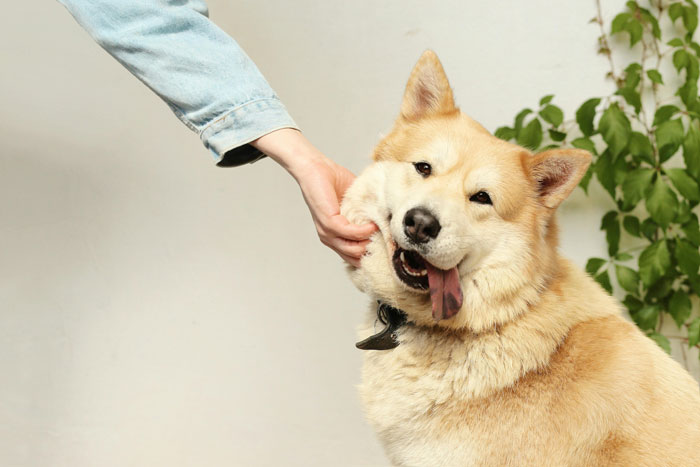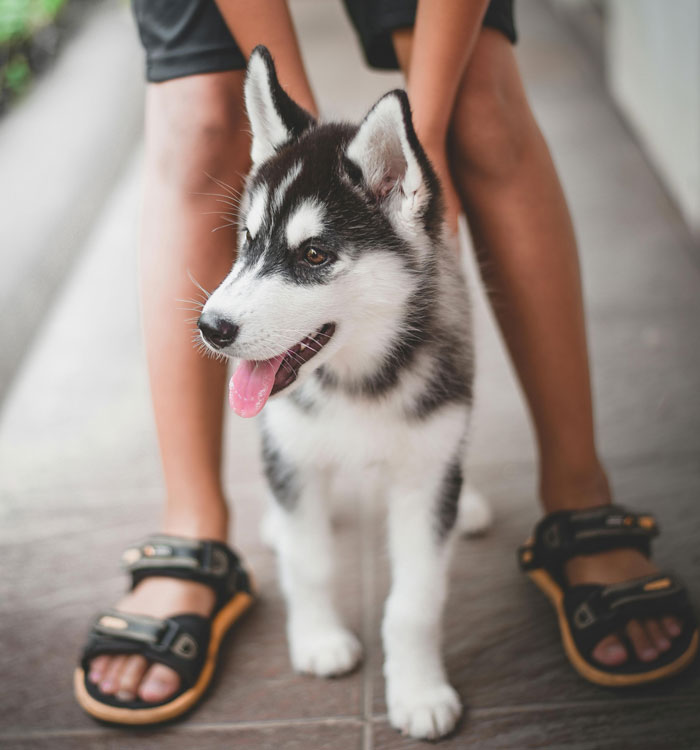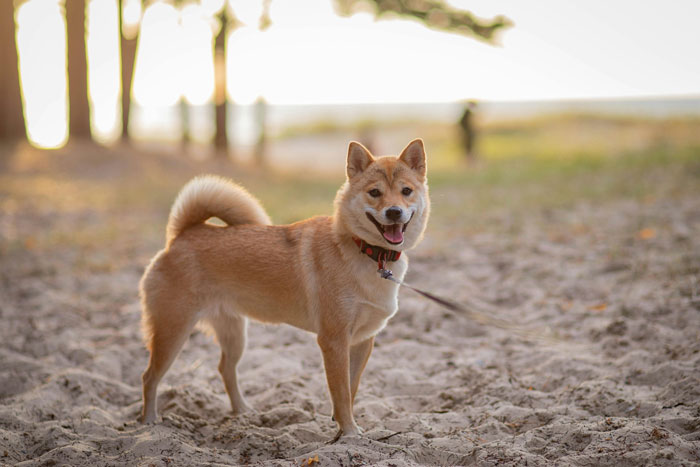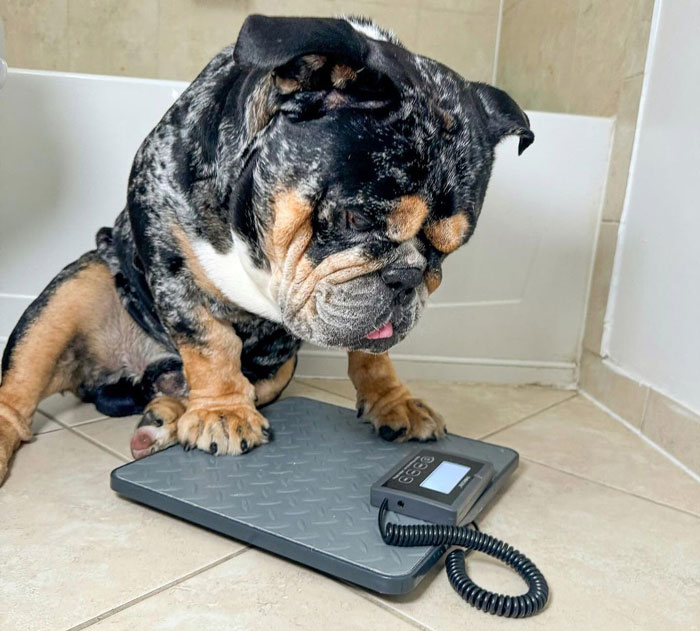
How Much Should My Dog Weigh? A Vet’s Guide to Healthy Weight Charts
Maintaining a healthy dog weight is one of the most impactful things you can do to ensure your dog’s longevity, well-being, and overall quality of life. Dogs at an ideal weight have a significantly reduced risk of serious diseases like arthritis, diabetes, and heart conditions. They can even live up to two years longer than their overweight counterparts.
However, a dog’s “ideal weight” isn’t just a number — several factors, including breed, activity level, age, and individual build influence it. For instance, breeds like greyhounds and whippets naturally build leaner than stockier breeds. The most effective approach to determining your dog’s ideal body weight combines visual cues with a tool called Body Condition Scoring (BCS).
The information provided herein is for informational purposes only. Please refer to our disclaimer for more details..
- How to Determine Ideal Weight
- Body Condition Scoring (BCS) – More Accurate Assessment
- The Importance of Breed Standards
- How to Calculate Your Dog’s Target Weight
- Additional Factors Influencing Healthy Weight
- How Much Should My Dog Weigh?
- Ideal Weight Chart: Popular Dog Breeds
- Why It’s Important to Know Your Dog’s Ideal Weight
How to Determine Ideal Weight
We’ll show you simple checks to assess your dog’s weight and introduce Body Condition Scoring (BCS) for a complete picture.
Visual Inspection
While charts can be a starting point, the best way to understand your dog’s weight is through simple visual checks. Here’s how to examine three key areas:
The Rib Test
Place your hands on both sides of your dog’s ribcage and gently run your fingers over their ribs. In a dog at an ideal weight, you should be able to feel their ribs easily, but they won’t be overly prominent.
There should be a slight layer of fat covering them. If the ribs are very visible or feel sharp with no fat covering, your dog might be underweight.
On the other hand, if you have to press hard to feel the ribs through a thick layer of fat, your dog is likely overweight.
The Overhead View
Stand directly above your dog and look at their overall shape. Ideally, you want to see a gentle inward curve behind the ribs, creating a subtle waistline. This is the classic “hourglass” figure.
An overweight dog will lose this definition, appearing more barrel-shaped or bulging outward at the waist.
An underweight dog will have an exaggerated inward curve or “tucked” waist. Keep in mind that natural variations exist between breeds. A Greyhound’s deep chest or a Bulldog’s stocky build will influence their overhead shape, so consider your dog’s breed.
The Side Profile
Look at your dog from the side, focusing on their belly area. Dogs at a healthy weight will have a visible “abdominal tuck” where the belly slopes gently upward after the ribs.
An overweight dog might have a sagging belly, a straight line from ribs to rear, or even a belly that bulges downwards. In an underweight dog, this abdominal tuck will be extreme, and the dog may appear gaunt.
These visual cues are a great starting point for understanding your dog’s weight status. To get the most precise assessment, combine these observations with a tool called Body Condition Scoring (BCS), which we’ll cover in the next section.
Body Condition Scoring (BCS) – More Accurate Assessment
Visual inspections are great, but for the most precise way to gauge your dog’s weight, it’s time to learn Body Condition Scoring (BCS). Veterinarians and animal experts worldwide use this tool.
What is BCS?
Consider BCS like a simple scale to determine if your dog is underweight, overweight, or at an ideal weight. There are two main versions:
- 5-Point Scale: This scale is more commonly used in North America. It focuses on broad categories (e.g., emaciated, underweight, ideal weight, overweight, obese), making it slightly easier for beginners to understand.
- 9-Point Scale: This scale is more prevalent in Europe and Australia. It provides a more nuanced assessment with finer distinctions between levels of body condition (e.g., very thin, thin, ideal weight, slightly overweight, overweight, obese).
Both scales rate your dog based on the visibility and feel of key areas like ribs, waistline, and abdominal fat.
Why use BCS?
- Standardized Approach: BCS helps ensure consistency, whether you’re monitoring your dog at home or discussing their weight with your vet.
- Beyond Visuals: While visual checks are important, BCS adds a sense of touch, providing a more complete picture.
- Track Progress: BCS is great for tracking weight changes over time, especially during weight loss or weight gain programs.
How to Perform an At-Home BCS Assessment
- Find a Reliable Chart: Search for a BCS chart specifically using the 9-point scale. It should include clear images or illustrations and detailed descriptions for each score. You can find a helpful BCS chart by the World Small Animal Veterinary Association (WSAVA) here: Body Condition Score Chart for Dogs.
- Combine Visuals with Touch: Review the visual cues we discussed, then add in a careful assessment of these areas:
- Ribs: Assess both how visible the ribs are and how easily you can feel them.
- Waistline: Look for the inward curve (or lack thereof) from above and the side.
- Abdominal Fat: Feel your dog’s underside to gauge fat deposits.
- Assign a Score: Based on the chart, determine which BCS score best matches your dog’s current condition.
Get comfortable with BCS. It may take some practice to master. Always discuss your dog’s BCS with your veterinarian. They can provide the most accurate interpretation and guidance, especially if your dog has any underlying health conditions.
Simplified BCS 9-point Scale
- 1/9: Emaciated.
- 2/9: Very thin.
- 3/9: Thin.
- 4-5/9: Ideal weight.
- 6/9: Overweight.
- 7/9: Heavy.
- 8/9: Obese.
- 9/9: Severely obese.
The Ideal BCS
On both the 5-point and 9-point scales, the middle scores represent an ideal body condition. For example:
- 9-Point Scale: Dogs with a BCS of 4 or 5 are considered ideal.
- 5-Point Scale: A BCS of 3 is considered ideal.
Remember, BCS and your vet’s expertise are the key to understanding and maintaining your dog’s healthiest weight!
The Importance of Breed Standards
Breed standards, which describe a breed’s ideal traits, often include a suggested weight range. Think of these ranges as a general guideline rather than an absolute rule. Even within a breed, a dog’s ideal weight depends on their size, build, and activity level. Always consider your individual dog and prioritize using visual checks and Body Condition Scoring (BCS).
Where to Find Breed Information
- National Breed Clubs: Look for your dog’s breed club, such as the American Kennel Club, The Kennel Club, or the Canadian Kennel Club.
- Reliable Websites: Veterinary websites like VCA Hospitals often have breed information sections.
How to Calculate Your Dog’s Target Weight
Now that you’ve determined your dog’s Body Condition Score (BCS), you can use it to estimate their ideal weight. Researchers at the University of Liverpool and Royal Canin developed this method.
Steps:
- Subtract 5 from BCS: Begin with your dog’s current BCS and subtract 5.
- Example: For a dog with a BCS of 8: 8 – 5 = 3
- Multiply by 10: Take the result from step 1 and multiply it by 10.
- Example: 3 x 10 = 30
- Add 100: Add 100 to the result from step 2.
- Example: 30 + 100 = 130
- Divide 100: Divide 100 by the result from step 3. Round your answer to three decimal places.
- Example: 100 / 130 = 0.769
- Multiply by Current Weight: Multiply the result from step 4 by your dog’s current weight. This will give you their estimated target weight.
Let’s say your dog’s current weight is 60 pounds. Then: 0.769 x 60 pounds = 46.14 pounds (round to 46.1 pounds).
Understanding the Formula
Here’s the formula used to calculate your dog’s target weight:
Target Weight = (Current Weight x 100) / (100 + (Starting BCS – 5) x 10)
Example with a 60-pound Dog:
Let’s use this formula with our 60-pound dog with a BCS of 8:
Target Weight = (60 x 100) / (100 + (8 – 5) x 10)
Target Weight = 6000 / (100 + 30)
Target Weight = 6000 / 130
Target Weight = 46.15 pounds (round to 46.2 pounds)
Conclusion: Based on this calculation, the ideal target weight for this dog would be approximately 46.15 kg. Since the starting BCS is 8 (indicating the dog is overweight), this would involve a weight loss program.
It’s crucial to consult with your veterinarian to determine a safe and healthy weight loss plan for your dog. They can provide a personalized target weight goal and guidance on adjusting dog food and exercise.
Additional Factors Influencing Healthy Weight
While BCS and breed standards are key tools, it’s essential to remember that several other factors play a role in your dog’s ideal weight.
- Breed Predispositions: Certain breeds are genetically more prone to obesity. Labrador Retrievers, Beagles, Dachshunds, and Golden Retrievers are notorious for loving food for your dog and tendency to gain weight easily. If you own one of these breeds (or a mix), be extra vigilant about monitoring their weight.
- Age: A healthy weight changes throughout a dog’s life. Puppies need extra calories for growth, while senior dogs often require fewer calories as their metabolism slows. Your vet can help establish the right weight goals for your dog’s life stage.
- Activity Level: Highly active dogs, like working breeds or sporting dogs, naturally have higher caloric needs than sedentary dogs. On the other hand, a couch potato pup requires less food to maintain a healthy weight. Your dog’s ideal weight should reflect their activity level.
- Overall Health: Medical conditions can impact a dog’s weight. For example, hypothyroidism (low thyroid function) can contribute to weight gain, while certain diseases can lead to unintended weight loss. It’s always best to discuss any significant weight changes with your veterinarian to rule out underlying health problems.
How Much Should My Dog Weigh?
Every dog is different so that healthy weights can vary even within the same breed. There are a few ways to get an idea of your dog’s potential adult size and weight:
- Parents’ Size: If possible, observing the size and weight of your puppy’s parents gives you a rough estimate.
- Breed Averages: Consult breed charts to see the average weight for a dog ranges for your dog’s breed and sex. Remember that these are just averages; several factors can influence your dog’s healthy weight.
If you don’t know the parents’ information, or if your dog falls outside the breed averages, don’t worry! Your veterinarian is the best resource. They can assess your dog’s body condition and overall health, alongside breed considerations, to determine their ideal weight range.
Ideal Weight Chart: Popular Dog Breeds
Breed weight ranges can be a helpful starting point, but individual dogs may vary. The following chart provides estimated weight ranges for popular breeds.
| Breed | Male (pounds/kg) | Female (pounds/kg) |
|---|---|---|
| Labrador Retriever | 65-80 (29-36) | 55-70 (25-32) |
| German Shepherd Dog | 65-90 (29-41) | 50-70 (23-32) |
| Golden Retriever | 65-75 (29-34) | 55-65 (25-29) |
| French Bulldog | under 28 (under 13) | under 28 (under 13) |
| Bulldog | 50 (23) | 40 (18) |
| Poodle (Standard) | 60-70 (27-32) | 40-50 (18-23) |
| Poodle (Miniature) | 10-15 (4.5-6.8) | 10-15 (4.5-6.8) |
| Poodle (Toy) | 4-6 (1.8-2.7) | 4-6 (1.8-2.7) |
| Beagle (13″ & under) | under 20 (under 9) | under 20 (under 9) |
| Beagle (13-15″) | 20-30 (9-14) | 20-30 (9-14) |
| Rottweiler | 95-135 (43-61) | 80-100 (36-45) |
| German Shorthaired Pointer | 55-70 (25-32) | 45-60 (20-27) |
| Dachshund (Standard) | 16-32 (7-15) | 16-32 (7-15) |
| Dachshund (Miniature) | 11 & under (under 5) | 11 & under (under 5) |
| Pembroke Welsh Corgi | up to 30 (up to 14) | up to 28 (up to 13) |
| Australian Shepherd | 50-65 (23-29) | 40-55 (18-25) |
| Yorkshire Terrier | 7 (3.2) | 7 (3.2) |
| Boxer | 65-80 (29-36) | 50-65 (23-29) |
| Doberman Pinscher | 75-100 (34-45) | 60-90 (27-41) |
| Cavalier King Charles Spaniel | 13-18 (5.9-8.2) | 13-18 (5.9-8.2) |
| Miniature Schnauzer | 11-20 (5-9) | 11-20 (5-9) |
| Great Dane | 140-175 (64-79) | 110-140 (50-64) |
| Siberian Husky | 45-60 (20-27) | 35-50 (16-23) |
| Bernese Mountain Dog | 80-115 (36-52) | 70-95 (32-43) |
| Cocker Spaniel | 25-30 (11-14) | 20-25 (9-11) |
| Brittany | 30-40 (14-18) | 30-40 (14-18) |
| Boston Terrier | 12-25 (5.4-11) | 12-25 (5.4-11) |
| Havanese | 7-13 (3.2-5.9) | 7-13 (3.2-5.9) |
| Shetland Sheepdog | 15-25 (6.8-11) | 15-25 (6.8-11) |
| Shih Tzu | 9-16 (4-7) | 9-16 (4-7) |
| Pug | 14-18 (6.4-8.2) | 14-18 (6.4-8.2) |
| Basset Hound | 40-65 (18-29) | 40-65 (18-29) |
| Bichon Frise | 12-18 (5.4-8.2) | 12-18 (5.4-8.2) |
These weight ranges are guidelines; a healthy weight can vary even within the same breed. Factors like sex, body frame, and activity level all play a role. Always prioritize your dog’s Body Condition Score and consult your veterinarian for the most accurate assessment of their ideal weight.
Why It’s Important to Know Your Dog’s Ideal Weight
Understanding your dog’s ideal body weight is crucial for their well-being, regardless of whether they need to lose weight. Knowing this target weight and regularly assessing their Body Condition Score empowers you to keep your dog in optimal shape. This proactive approach helps prevent the health problems associated with being overweight or underweight.
- If your dog does need to lose or gain weight, their ideal weight provides a specific goal. Your veterinarian can then use this information to develop a tailored weight and body condition management plan, including the right caloric intake and appropriate exercise recommendations.
- Regularly tracking weight and BCS allows you to catch changes early, whether it’s gradual weight gain or unexplained weight loss. Early intervention is always better! Sometimes, unexpected weight loss is the first sign of an underlying health problem. Knowing your dog’s ideal weight helps you and your vet quickly recognize changes that might otherwise go unnoticed, allowing for prompt investigation.
- Many dog breeds, like terriers, have specific weight ranges within the AKC standards. Knowing these standards can help you understand if your purebred dog is within a healthy range for their breed.
- Understanding ideal weight ranges for similar-sized breeds can offer valuable insights, even for mixed breeds.
- Smaller breeds may require different considerations for weight management compared to larger breeds.
- Knowing your dog’s size and ideal weight helps you make informed decisions about portion sizes and kibble amounts.
- 2024 may bring new research and insights into canine weight management, so staying up-to-date on the latest information is crucial.
- Dogs love treats, but it’s important to factor them into their daily caloric intake to avoid unwanted weight gain.
Understanding and managing your dog’s weight prepares them for a long, happy, and healthy life.
2Kviews
Share on Facebook
 Dark Mode
Dark Mode 

 No fees, cancel anytime
No fees, cancel anytime 


 Image credits:
Image credits:  Image credits:
Image credits:  Image credits:
Image credits:  Image credits:
Image credits:  Image credits:
Image credits: 
























4
0